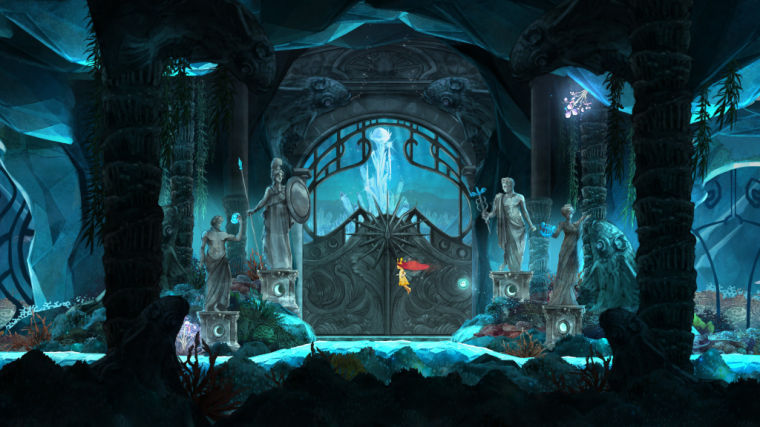‘Child of Light’: a stunning 2D artistic achievement
May 20, 2014
“Child of Light”
Developer: Ubisoft Montreal
Grade: A
“Child of Light” is like a course in video game and art history.
It mixes a hero’s journey with Perrault, Freud, Disney, the role-playing game and side-scroller. Essentially, “Child of Light” weaves a few disparate themes and genres together and presents them as a luminous and breathtaking adventure story. Conveniently, the game is available on nearly every current platform via digital download: Steam, PlayStation Network, Xbox Live and Wii U’s Nintendo eShop.
Aesthetically, “Child of Light” embodies a watercolor impressionist painting. Its art style is the best of its many impressive features and seems to borrow a few elements from other highly regarded “art” games, like Jonathan Blow’s “Braid,” Fumito Ueda’s “Ico” and Clover Studio’s “Okami.” The game was designed to resemble the works of Hayao Miyazaki (the genius film director behind “Spirited Away” and “My Neighbor Totoro”) and illustrious “Final Fantasy” series artist Yoshitaka Amano — two of the most famous and influential Japanese artists alive.
The game follows Princess Aurora, the daughter of an Austrian duke in 1895. Aurora’s mother used to tell her stories of the lost kingdom of Lemuria, but she’s no longer around. On the night of the duke’s second marriage, the princess unknowingly falls into a slumber in the vein of “Sleeping Beauty” and awakens in the fantastical Lemuria. She thinks she’s dreaming, but eventually a seer tells her that she cannot wake.
The seer, known as The Lady of the Forest, tasks Aurora with a quest of cosmic importance — she must recover the sun, moon and stars from Umbra, the Queen of the Night, who has cursed Lemuria to be a place of shadows and darkness. Banishing Umbra is the only means for Aurora to go home. It’s an old story but, to use an even older phrase, it’s never been told like this before.
Despite being produced by Ubisoft — one of the world’s highest-budgeted game studios — the studio’s efforts look much more like a small indie designer’s, along the lines of Thatgamecompany’s massive hit “Journey” in 2012.
A lot of it has to do with the game’s scoring by Canadian singer Coeur de pirate, which is notably minimalist but memorable, haunting, beautiful and melancholy in its moments. “Aurora’s Theme,” which plays on the title screen, evokes a quiet and contemplative atmosphere and sets the tone perfectly.
Even though it’s a 2D side-scroller, myriad paths appear throughout the map, and the game is actually much larger in scope than it initially appears. Many chests and collectibles hide away behind paths of thorns that can hurt Aurora.
She eventually earns a set of wings that makes traversal fluid and rapid, but early puzzle solving vividly reflects the character’s hesitation and timidity upon entering lightless caves in an unfamiliar world. If Aurora’s left to sit in the field, her massive tangle of Ariel-red hair flickers and swirls in the wind in one of the game’s most enchanting animations.
On the map, foes pace in designated areas and can be engaged at the player’s will. Battles take place on a separate screen through a variation of the “Final Fantasy” Active Time Battle (ATB) system. A meter fills up until Aurora and her party can act, and then a “Cast” window displays how long the command takes to register. Enemy attacks can be interrupted if timed properly, but it works in reverse, too. If the enemy has the upper hand, Aurora has a “Defend” command to reduce damage and prevent interruption.
One of the most interesting gameplay additions comes with the archetypal companion character: Aurora meets Igniculus, a talking blue firefly, early on in the story and once they’re acquainted, the player has the means to control Aurora with the left analog stick and Igniculus with the right.
Igniculus has the power to “glow,” which can heal Aurora or slow down the enemy’s ATB gauge during battle, which is extremely useful in fights in which the enemies use spells to increase their speed. He becomes an important ally, especially considering that some puzzles and areas are incompletable without his assistance. Additionally, those so inclined can utilize a second controller to make the game two-player, with the second player controlling Igniculus.
The game’s dialogue is written almost exclusively in verse, in what seems to be an ode to Square’s painfully unknown “Vagrant Story” and to the rhymes of William Shakespeare. It might seem unimportant, but the depth of the text adds the final nuanced touch to this wildly imaginative fairy tale.
“Child of Light” doesn’t just draw design from its artistic predecessors, but archaic “shalts” and “thous” as well, complementing an already impressive visual experience with a soulfully auditory one.








